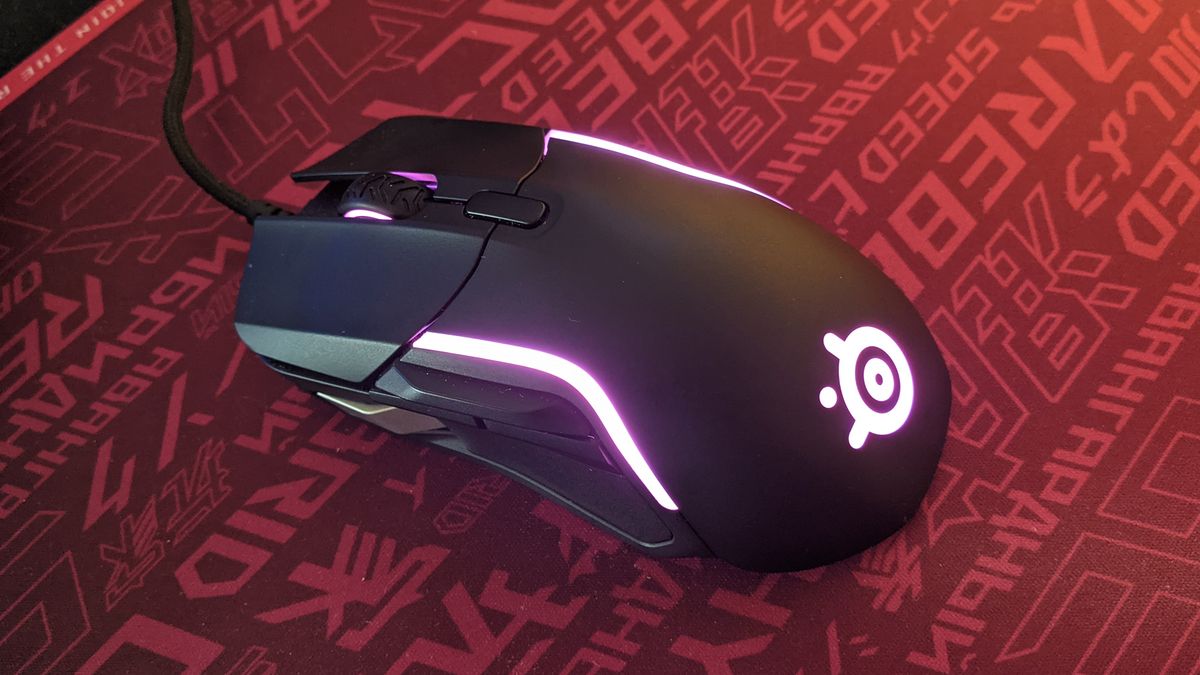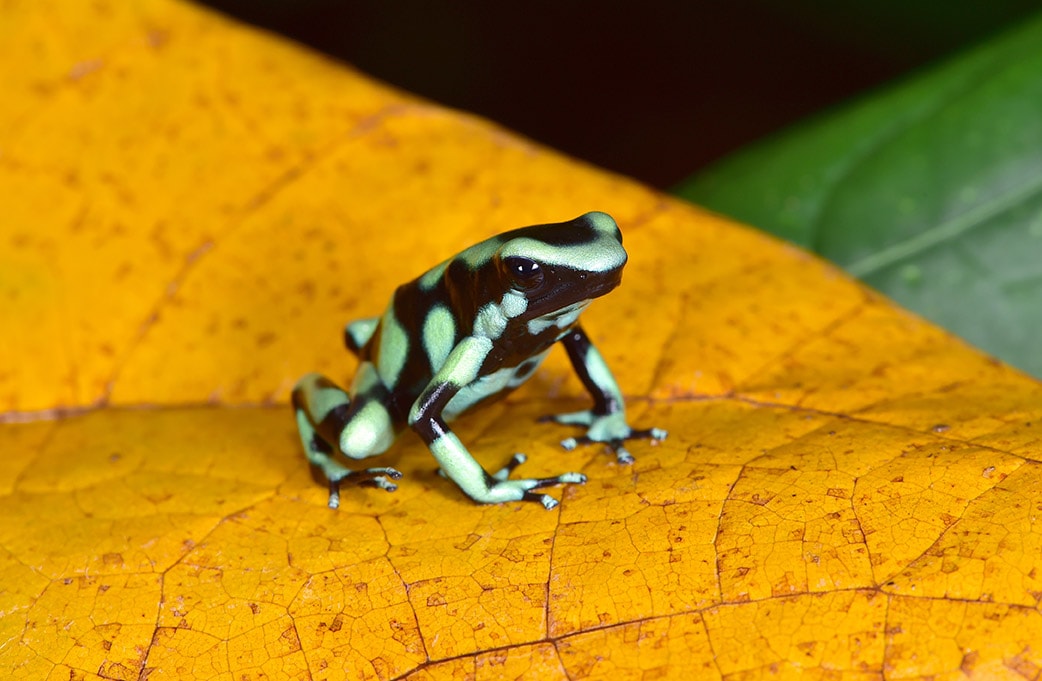

Beautiful but dangerous, poison dart frogs have long captivated the imagination of many. Hailing from Central and South America, these frogs are particularly unique due to the toxins on their skin. The Green and Black Poison Dart Frog is a mixture of bright green and dark black, with its skin tone acting as a warning display to predators that it might not be the best choice of meal.
In captivity, these frogs can live for more than 10 years and require little in the way of care. You’ll have to get their habitat right and meet their temperature and humidity needs, but overall, a Green and Black Poison Dart Frog makes a great hobby pet for anyone who loves exotic amphibians, whether they’re new to caring for them or have years of experience.

Quick Facts about Green & Black Poison Dart Frogs
| Species Name: | Dendrobates auratus |
| Family: | Dendrobatidae |
| Care Level: | Low-moderate |
| Temperature: | 70º-85º Fahrenheit |
| Temperament: | Docile |
| Color Form: | Green and black |
| Lifespan: | 10+ years |
| Size: | 1-2 inches |
| Diet: | Insects |
| Minimum Tank Size: | 10 gallons |
| Tank Set-Up: | Tropical |
| Compatibility: | Beginner to expert |
Green & Black Poison Dart Frog Overview
While Green and Black Poison Dart Frogs are spectacular in appearance, it’s not their looks that make them unique. Rather, it’s the toxins that their skin produces. These toxins are actually used by natives in the frog’s natural region for hunting purposes; they apply the toxin to darts and arrows to ensure a quicker death on their prey.
Luckily, the toxin in a poison dart frog’s skin comes from the prey it eats. In captivity, these frogs aren’t eating the same formicine ants that they’d eat in the wild, and it’s these ants that give poison dart frogs their toxins. Without those ants, these frogs don’t produce any toxins on their own, so they’re safe to keep as pets. That said, you should still be careful. Wild-caught specimens are far less common than captive-bred on the pet market, but if you end up with a wild-caught poison dart frog, it will still be somewhat toxic, even if it hasn’t eaten any toxin-containing ants in some time.
Instead of ants, your pet poison dart frog will be eating a steady diet of feeder insects like crickets, fruit flies, or small beetles. Their habitat will have to stay humid with a steady temperature in the 70s and 80s. Their care needs are minimal, which is why these frogs are a good fit for a first-time amphibian owner. But this isn’t the type of pet you’re going to bring out and handle a lot. In fact, you should never handle your Green and Black Poison Dart Frog unless it’s unavoidable. Handling your frog can cause undue stress, which is unhealthy for the frog.
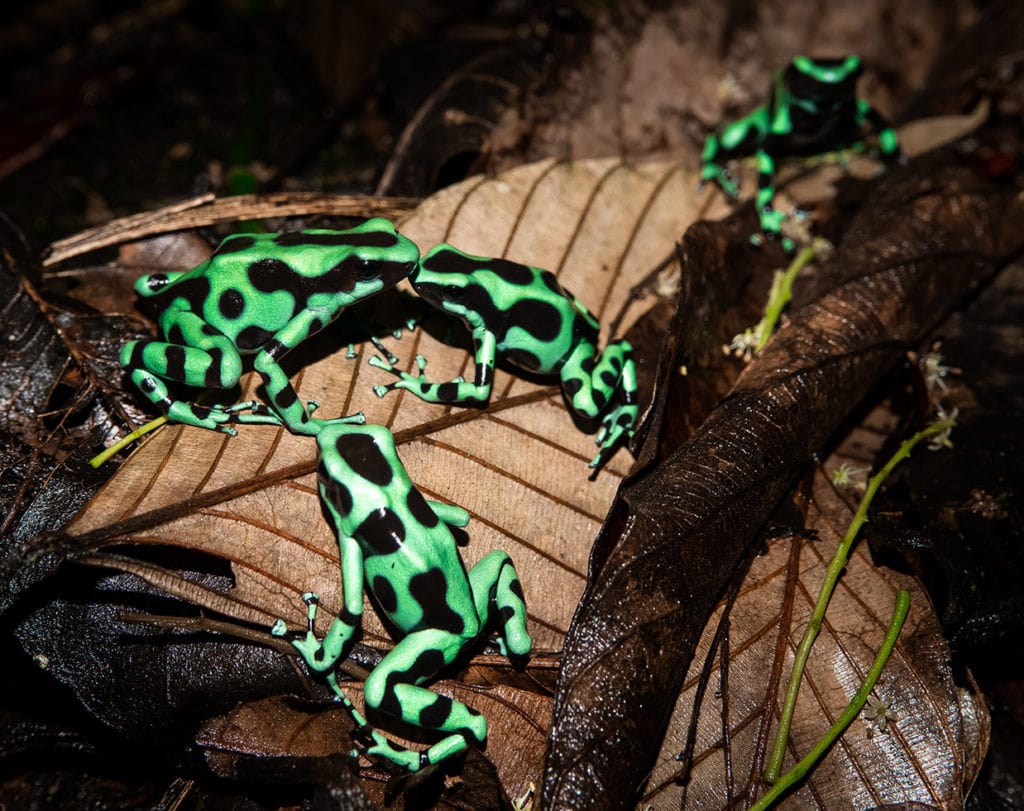
How Much Do Green & Black Poison Dart Frogs Cost?
As far as exotic pets go, Green and Black Poison Dart Frogs are quite affordable. On average, you should expect to spend about $40-$60 for a healthy, captive-bred specimen. Remember, if you order through an online vendor, you’ll also have to account for shipping costs, which can cost an additional $40-$60 as well, though you can usually ship as many animals as you’d like for that flat fee. And don’t forget to budget for the cost of a habitat, substrate, heating pad, lights, and everything else your frog will need in its habitat.
Typical Behavior & Temperament
These are rather shy frogs, and you’ll usually find them either basking in the light and warmth or hiding under some growth. Because they’re so shy, you’re more likely to see your frog if you provide lots of hiding spots in the enclosure, as they will make it feel safer and more secure. They’re not aggressive frogs, but they also shouldn’t be handled more than necessary. Handling your poison dart frog can stress it out and cause health problems.
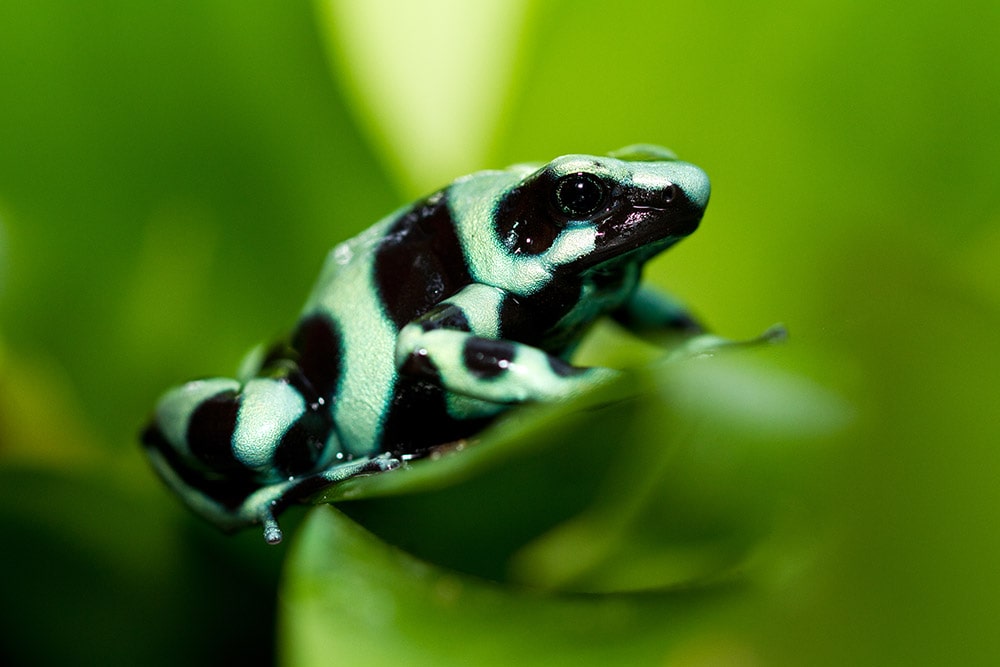
Appearance & Varieties
As you might glean from the name, Green and Black Poison Dart Frogs are generally green and black. However, they do display quite a bit of variance in their appearance. Their colors can range drastically. The black portions of your frog could be pitch black or they could be a shade of bronze or brown ranging from light to dark. Green portions can be stripes, spots, or even bands, and they might not even be green. While bright green is the most common color, their coloration can range from green to blue and pretty much any hue between the two.

How to Take Care of Green & Black Poison Dart Frog
Habitat, Tank Conditions & Setup
Green and Black Poison Dart Frogs aren’t the type of pet you’re going to be pulling out of its enclosure and taking around with you. These frogs will spend their entire lives in the habitat you build for them, so you must provide everything they need.
Enclosure
It’s recommended that you use a glass terrarium for poison dart frogs as the glass allows heat to dissipate better than other materials. Ten gallons of space per frog is where you’ll want to start, though more space is always welcome.
Substrate
Your frog needs to stay moist, so its substrate must also retain moisture. You’ll need to spray the substrate down regularly so it stays semi-wet and doesn’t dry out, but you also don’t want it to get soggy or grow mold. Some of the best substrate options include several types of moss such as green sphagnum moss and compressed forest moss, or other mediums like coconut fiber.
Temperature
These poison dart frogs will thrive in temperatures between 70-85 degrees Fahrenheit. They prefer temperatures to remain in the low 70s, though they can tolerate short dips down to 65 degrees. Temperatures above 85 degrees can be dangerous, however, so never let your frog’s terrarium get too hot. Make sure to monitor the habitat with a thermometer. A heating pad attached to one of the terrarium walls is a great way to keep the enclosure at the right temperature.
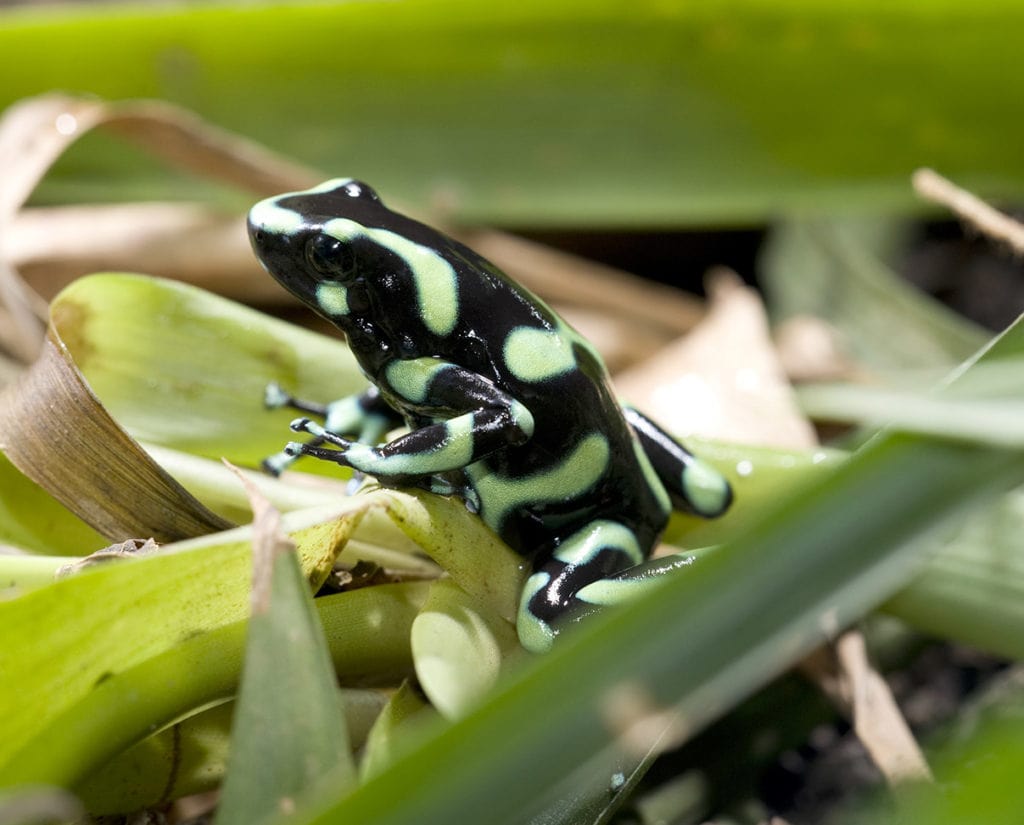
Humidity
Just as important as the temperature in your frog’s enclosure is the humidity level. Poison dart frogs need the humidity to remain between 70% and 100%. They can survive short spans of 50% humidity as long as they have access to plenty of water, but you’ll want to keep humidity above 70% as much as possible. You’ll need a hygrometer to monitor the humidity levels. Our favorites can be mounted inside the cage with a digital readout of humidity and temperature, so you only need one device.
Light
Poison dart frogs need natural light, and a basic fluorescent terrarium bulb will do. Simply run it during daylight hours and shut it off at night.
Hiding Places
The more hiding places that are available in your frog’s enclosure, the more secure it will feel. This will cause it to come out more where it’s visible. Live plants make some of the best hiding places, along with coconut husks, hollowed logs, and anywhere else your frog can crawl inside or curl under.
Can Green & Black Poison Dart Frogs Be Housed Together?
Opinions vary about how many Green and Black Poison Dart Frogs should be kept together, but one thing that seems universally agreed upon is that they should never be mixed with other species. Keep these frogs alone or with other Green and Black Poison Dart Frogs.
If you provide enough space, you can house multiple Green and Black Poison Dart Frogs together. However, some aggression can occur if you do. This is generally based around mating practices. Females may even eat others’ eggs. Sometimes, females even fight over mates. That said, many breeders believe the aggression is minor and that these still make great group frogs overall.
Another option is to keep them in pairs. Since females are more aggressive than males by far, you’re less likely to see aggressive behaviors with only one female in the enclosure.

What to Feed Your Green & Black Poison Dart Frog
In the wild, these frogs eat a varied and diverse diet, so you should try to mimic this if possible. Granted, it’s not always easy to come by exotic feeder insects, so you’ve got to make do with what’s available. Fruit flies are a great choice because they’re small, easy to keep, and your frog will love them. Pinhead crickets are also an ideal insect to offer a Green and Black Poison Dart Frog. Keep in mind that these frogs are only about 1.5 inches long. They’re tiny, and they need appropriately small food. Other options include springtails, isopods, and small beetles.
Before feeding insects to your frog, you should always gut-load them and dust them with a vitamin and mineral supplement. The vitamin supplement can be easily sprinkled on top of the insects and provides vital nutrients for your frog. Gut loading is the process of fattening up the insects and filling their stomachs with nutrients that your frog will benefit from. You can use a gut-load feeder for insects or simply feed the insects fruits, vegetables, and fish flakes.
Keeping Your Green & Black Poison Dart Frog Healthy
One of the reasons that these frogs make great pets for beginners is that they’re naturally hardy and resilient. You don’t have to do much to keep your Green and Black Poison Dart Frog in good health. Just make sure it has ample space and plenty of food. Keep its enclosure between 70-85 degrees Fahrenheit with humidity of 70% or higher. Ensure there’s constant access to water and adequate ventilation with standard daily light cycles and your frog should remain in great health, barring an accident or stroke of bad luck.
Breeding
Breeding Green and Black Poison Dart Frogs is pretty simple. If you house a male and female together as a pair, you’re likely going to end up with baby frogs. Females often lay repeatedly for a period before ceasing to lay at all for several months. Eggs will be laid on a large leaf usually, but if you put a small petri dish under a coconut husk, she’ll likely lay the eggs there instead.
Eggs will hatch soon, becoming tiny tadpoles. After 60-80 days, the tadpoles will be frogs, though much smaller than your adults. Young are laid in clutches of 4-6, so if your frogs start breeding, your numbers will be multiplying quickly.

Are Green & Black Poison Dart Frogs Suitable For You?
Whether you’re brand new to caring for amphibians or you’ve been doing it for years, Green and Black Poison Dart Frogs can be a great fit. Just keep in mind that these are hobby pets. You’re going to be caring for your frog and observing it, but you won’t really be handling it.
These are hardy frogs with minimal care needs, which is why they’re so beginner-friendly. Additionally, they’re quite affordable and have minimal recurring costs, making them even better as first-time exotic pets. But if you’re looking for a pet that you can play with and hold, you’ll be better off continuing your search, as that’s not the kind of pet you’re getting with a Green and Black Poison Dart Frog.
Featured Image Credit: worldswildlifewonders, Shutterstock
An avid outdoorsman, Dean spends much of his time adventuring through the diverse terrain of the southwest United States with his closest companion, his dog, Gohan. He gains experience on a full-time journey of exploration. For Dean, few passions lie closer to his heart than learning. An apt researcher and reader, he loves to investigate interesting topics such as history, economics, relationships, pets, politics, and more.

